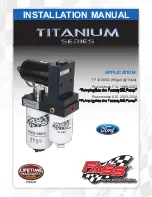
A. Air-Fuel Ratio
Start Air-Fuel ratio, normal start Air-Fuel ratio, clear the
flooded cylinder Air-Fuel ratio, engine running Air-Fuel
ratio, cooling state Air-Fuel ratio, warm-up state Air-Fuel
ratio, theoretical Air-Fuel ratio, power-enriched Air-Fuel
ratio, catalytic overheating protection Air-Fuel ratio, engine
overheating protection Air-Fuel ratio.
B. Intake Manifold Absolute Pressure
Intake manifold absolute pressure is detected by the MAP
sensor installed on the intake manifold.
C. Volumetric Efficiency
Volumetric efficiency is the actual air flow into the cylinder
to the ideal air flow ratio.
D. Phase Volumetric Efficiency
The valve timing changes affect the engine's volumetric
efficiency. The basic efficiency table is set when the valve
timing control system has not started to work, the camshaft
and the crankshaft are at initial positions. When the valve
timing control system starts to work, the system will
compensate the volumetric efficiency to ensure an accurate
calculation of air flow.
E. Self Learn
self learn does not amend the changes as the engine
running time increases, or the engine and vehicle
manufacturing errors.
F. Close-loop Feedback Correction
Close-loop feedback correction controls the actual Air-Fuel
ratio close to the theoretical Air-Fuel ratio through the
oxygen sensor feedback signals.
G. Transition Condition Fuel Control
System uses more complex algorithms to establish the fuel
evaporation model to calculate Air-Fuel mixing conditions,
taking into account the engine coolant temperature, intake
air temperature and engine working condition and the best
fuel injection amount. It greatly improves fuel control under
various transitional working conditions, including sudden
acceleration/ deceleration and other working conditions.
H. Protective Fuel Supply Control
When any one of the following conditions is met, the system
will stop fuel injection:
–
When the engine speed is higher than 6,400 rpm,
resume fuel supply when the engine speed drops below
6,000 rpm.
–
When the system detects a ignition system malfunction,
it stops the fuel supply.
–
When the system voltage is greater than 18 V, it will
enter the electronic throttle body function restriction
mode (forced idle mode).
I. Basic Fuel Injection Constant
The basic fuel injection constant provides engine
displacement and the fuel injector fuel flow rate
relationship.
J. Battery Voltage Amendment
When the battery voltage changes, voltage is amended to
ensure the correct amount of fuel injection.
2.12.3.3 ECM Controlled Ignition System
1. Closed Ignition Angle Control
The length the ignition angle closes determines the spark plug
ignition energy. Ignition coil magnetizing too long will damage
the coil or ECM internal ignition coil driver circuit, while too short
will cause ignition failure (misfire).
2. Starting Mode
In the starting mode, the system uses a fixed ignition angle in
order to ensure cylinder mixture is ignited, and provide positive
torque. When the engine starts to run, the engine speed
increases. The ignition angle will no longer be in starting mode.
Engine
Control System JL4G15-D
2-595
EC718/EC718RV EC715/EC715RV 10/2009
Summary of Contents for EC715 2009
Page 4: ......
Page 330: ...Next Step 10 End 2 248 Fuel System JL4G18 D Engine EC718 EC718RV EC715 EC715RV 10 2009 ...
Page 1164: ......
Page 2008: ......
















































